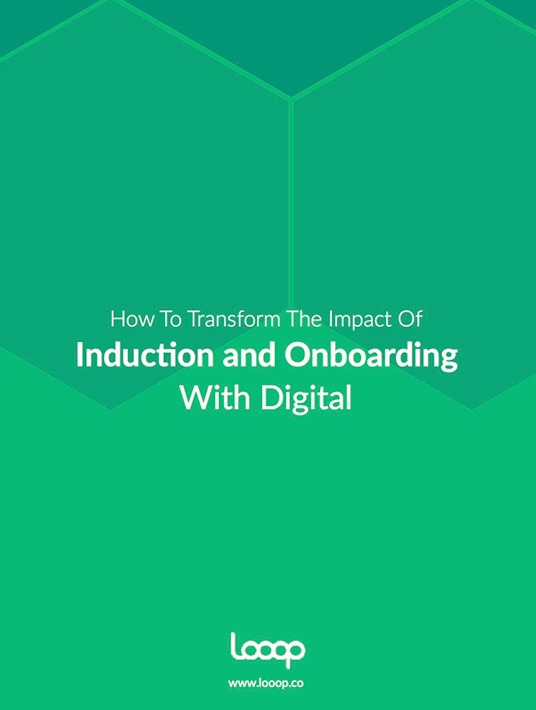Induction And Onboarding With Digital: Being Where New Starters Are
By incorporating technology into the Induction process, the organization not only goes to where the people are, but also capitalizes on the 3 stages of Induction to steer them towards information they require at their point-of-need.

Let’s begin with stage 1: What happens just before your new employee arrives at their desk for the first time?
Stage 1: From ‘Yes’ To ‘Desk’ (Before Day One)
It’s common for new starters to have questions or doubts when starting a new job. Why not use these 5 resources to address these straight away and replace their apprehension with excitement and readiness from the moment they accept the job offer (“Yes”), to when they arrive on Day One (“Desk”)?
- What to expect on my first day.
Imagine you’re telling a close friend what to expect on their first day at your company. Let them know if there will be an Induction event, lunch with their colleagues, to expect to meet a lot of people, and to just take in as much as they can. - Things to prepare before I start.
There may be some paperwork they need to bring with them, or they may need to bring in their passport, or you may wish to share some advice that will help make things easier for them when they arrive. - Where my department fits into the company.
The context of where you fit in is important in any aspect of life, and whilst providing your new employee with this useful insight you are also laying the foundations of understanding their role a little better. - Meet the team.
Remembering people and names is hard in any new job, so share some information about your candidate’s immediate team with a short video or head shots and text. Help them to connect with team mates and get a head-start on Day One. - What to wear around the office.
Don’t underestimate the very basic need to fit in – and not stand out for the wrong reasons. Office dress codes aren’t as cut and dry as they used to be, so share what you know (the explicit and implicit rules) about what to wear at your office – and with clients (if that’s different).
All it takes initially is 5 resources. The focus should not to be to ‘train’ new starters before they join, but giving them useful resources to prepare for their new role.
Stage 2: Day One/Week One
New starters need a great deal of guidance during their initial stages at a new company but ‘content dumping’—even in bite-sized chunks— won’t help them. Think about what the new starters will be trying to do during their first day and first week – and frame these as questions. Guide them forwards with experience that individuals within the organization already have.
Here are the top 5 resources that work in other companies:
- How do I get off to a good start at (your company)?
Include tips that work in your company, like: Spend time with your line manager to understand short-term goals, meet your team mates, introduce yourself to clients and stakeholders and find out what problems they need you to solve for them, etc. - What do I need to do to set up my technology?
If not hardware, then certainly making sense of software, i.e. what system to use and when. - What do I need to understand regarding my regulatory responsibilities?
This could be a link to your online compliance training or you could address these in other resources on Looop. - How do I really get to know the company?
This may make reference to: Getting the most of ‘Meet and Greets’, finding useful information inside the company, asking good questions, etc. - What do successful employees wish they’d known from the start?
This could be a really powerful set of quotes from—or a video montage of—recent new starters describing that they wish they’d known. People love real stories and they can be more than worth your time in gathering.
Stage 3: Up To 3 Months
We have all been new starters at one point or another, so we understand how difficult it can be to establish ourselves in a new team and demonstrate our value. Everybody’s role is different and it can be challenging to understand where we fit into an organization. You can’t expect to deliver a course for all of this, but you can use digital resources to show the way of getting things done, based upon the paths that other successful employees have trodden.
Useful resources during this stage include:
- How do I request annual leave / process expenses, etc?
Don’t train new starters on internal systems; instead, break down the steps that they’ll be expected to perform into resources that support and guide them while they are working. - How do successful employees get on here?
This is a really powerful way of expressing the accepted and rewarded behaviors in your company. Phrasing these in a way that appeals to the motivations of ambitious new starters can help you to influence the way they learn to perform at your company. - What development opportunities are there for me at the company?
It might still be early days, but ambitious people are climbing their own ladder and want to know how you might help them. Don’t just outline what provision you have in place in terms of courses and programs; share what successful people in your organization do in order to develop. - How should I run my P&L here?
Budgets are just one example of an internal process that’s specific to an organization. Where an employee has a role responsibility that relies on unique internal know-how, unpack processes to provide both a high-level overview and more detailed practical steps. - If there was just one more thing…?
Ask recent new starters if anything is missing from this list that would have made their Induction better. I’m going to guess that there is at least one more thing that your people would thank you for sharing because it helps them to establish themselves more quickly in your company. Push yourself to find that one more thing.
Final Word: Refocusing Face-To-Face Induction
There is huge value in bringing people together during Induction but not for content dumping or attempts to transfer knowledge. An article by Charles Jennings looked into the myth of ‘knowledge transfer’ and found:
“We can’t and don’t transfer knowledge between people. We transfer information. A subtle but important distinction.
We can create and use techniques and approaches that help and facilitate knowledge acquisition. We can share information in the form of data and our own insights. We can create environments where people are likely to have their own insights—their lightbulb moments—and we can help people extract meaning and learn through their own experiences.
But we don’t transfer knowledge. Not between people, or even between organizations.”
Induction should focus on new starters networking with other new starters, meeting recent new starters, and meetings with established employees - all with the focus of welcoming them and working on connections, rather than Knowledge Transfer.
Remember, Induction exists to build the new starters’ confidence to feel comfortable and competent within the organization. Spend more time on meaningfully connecting new starters with each other and getting them really excited about joining the company.
Related Articles:
- Free eBook: How To Transform The Impact Of Induction And Onboarding With Digital
- How Can Technology Help The Onboarding Process?








